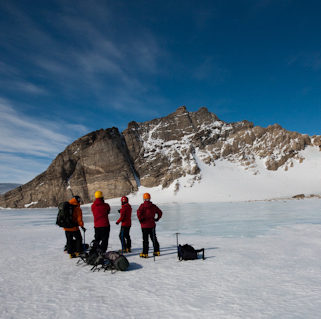In the world of earth and environmental sciences, faculty and investigators recognize a problem with self-replication in their disciplines due to a historical tendency to recruit students whose traits and backgrounds resemble their own. Dr. Christine Siddoway is aware that the issue is even more of a concern for polar science and is determined to study this further in her ongoing work with bedrock geology in Antarctica.
Siddoway has a vision of change. She believes in nurturing the next generation of polar researchers without pushing them into the same molds that have stifled innovation for years. "I've been offering courses that provide opportunities for Antarctic research," she says. "And the students can choose to register for these courses based on their own interest in the subject, rather than through persuasion from me.”
Unlike the traditional lecture-based classes, Siddoway's students delve into experiments with uncertain outcomes. They learn techniques and use specialized instrumentation to obtain data, then gain firsthand experience in interpreting the data. Siddoway believes that hands-on experience is the key to sparking genuine interest in polar studies.
"For the first time in polar science," Siddoway says, her eyes shining with excitement, "investigators are beginning to identify the interrelationships between the ice sheet and the bedrock, and it's coming to the fore in Antarctica and Greenland, where the ice sheets are going away due to climate warming."
Siddoway’s work is focused on unraveling the mysteries of the bedrock beneath the ice. "The bedrock of West Antarctica essentially was not known until gains in knowledge obtained since the 1970s or so,” she says. “CC students who initially worked on-continent with me were a part of just getting the outcrop geology down. Now the work is about what's under the ice. What's the geology that we can't see?"
As Siddoway speaks passionately about her work, it’s clear that she is not only dedicated to her research but also to the education and empowerment of future scientists. Her courses are not just an opportunity for students to learn but a chance to be part of something groundbreaking, illuminating the unseen world beneath the ice, and helping address new priorities in the ever-evolving field of polar research.
Siddoway, her students, and CC alumni have joined in developing a ground-breaking geospatial resource for Antarctic research, opening up new ways to understand the frozen continent. They, and an international team coordinated by GNS Science, Aotearoa-New Zealand, created GeoMAP Antarctica to be the first detailed digital database that collates all the existing geological data of Antarctica.
Online, open-access geological data already exists for the other continents worldwide, and is crucial for comprehending and predicting the swift global transformations occurring on our planet. The alterations in the Antarctic ecosystem are progressing at a faster pace than in other areas. Therefore, there was an immediate requirement to expedite the creation of GeoMap Antarctica's precise digital archive of the known surface geology of the continent. This resource will serve as an invaluable open-access asset, offering immediate and enduring value to researchers in the present and the future.
To create Antarctic Geomap, students and alumni applied skills gained through CC courses to extract information from 20th Century hand-drawn maps, digitize hard-copy regional maps, and then integrate the information into modern, high-resolution datasets within a geospatial data framework.
Simon Cox, the project leader hailing from GNS Science in Aotearoa-New Zealand, describes GeoMAP as a sort of Antarctic geology Wikipedia. “We purposefully created GeoMAP to be a fundamental, continent-wide, and open-access collection of datasets of geological information, compiled into a modern mapping framework. We believe GeoMAP will be used in, and evolve with, a wide breadth of future research across the world,” says Cox.
Belinda Smith Lyttle, the lead data architect at GNS Science, highlights GeoMap as a resource not only for geologists but for glaciologists and climate scientists who are documenting ice sheet change. GeoMAP has been designed with the flexibility to evolve and improve over time, adapting to new research findings.
Publishing this database involved international cooperative work by geologists from seven Antarctic programs and 14 nations. Of the 29 co-authors, seven are from USA and five are graduates or faculty of CC.
Several alumni became involved in the Antarctic geospatial and BigData project while they were undergrads at CC, and the participation for two of them was funded by the Witter Family Fund for internships in Geology. Three are now employed in geology or fields related to the work of their internships. Sam Elkind ’16, the first CC participant in the program, was supported by the Witter Family internship in its inaugural year. Elkind remained directly involved in the work of the Antarctic geological project throughout its full duration. He received his master’s in Computer Science from Georgia Tech, gaining skills in coding and software design that he brought to bear on the international Antarctic dataset being released in Scientific Data. His contributions are so great that he is listed third in the authorship of the work being published in the Nature family of publications. Other CC co-authors are Lexie Millikin ’17, Tristan White ’18, and Paul Morin ’15.



